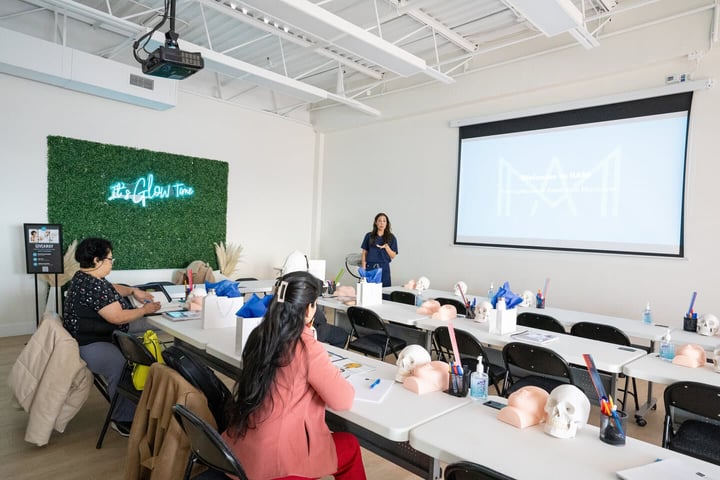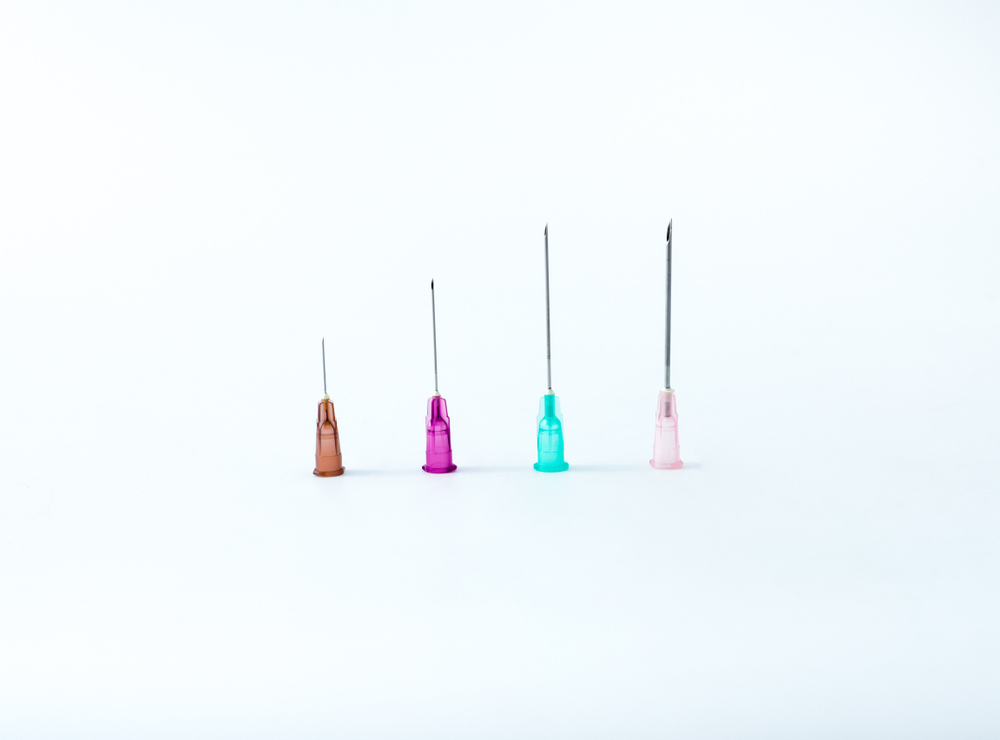Lip Filler Migration: How to Fix and Prevent
Migrated Lip Filler
More and more patients choose to get fillers to plump their lips. Achieving beautiful, natural-looking lip enhancement is an art. When properly done by a skilled professional, the treatment can give gorgeous, full lips. But sometimes, things can go wrong. One problem that can happen is something called "lip filler migration."
It occurs when the filler moves from where it was injected. When these complications happen, they leave patients unhappy and practitioners frustrated.
The good news is there are ways to fix lip filler migration. And there are things you can do to try to stop it from happening in the first place. This blog post explores why lip fillers migrate, how to fix migrated lip fillers, and how to prevent the phenomenon.
Understanding Lip Filler Migration
First, what exactly is lip filler migration? When a lip filler shifts from its injected position to another area of the lips or face, this movement is called migration. It may happen shortly after injection or gradually over several weeks or months. The effects range from mild to moderate asymmetry to major distortion in lip shape.
Sometimes, the filler only moves a little bit. It creates a small "ledge" just past the lip line. Other times, it moves a lot, creating a big shelf or bump above the top lip. That gives a patient "duck lips." Other times, the filler bunches up and makes little lumps on the lip border. However it moves, migrated lip filler makes lips look strange instead of beautiful.
Patients often describe migrated filler as making their lips look cartoonish or clown-like. That is clearly an undesirable outcome!
Why Do Lip Fillers Migrate?
Filler migration tends to result from product selection or injection methods issues. By understanding the root causes, we can make educated choices to avoid migration. Here are a few reasons lip fillers might migrate or move around.
Injection Method
The techniques used to introduce fillers into the lips significantly impact the risk of filler migration. Incorrect placement and improper depth cause the most issues.
Some injection techniques make migration more likely to happen. One is something called the "Russian lip technique." This method makes the lips look very full, like a doll's. But it involves a lot of little punctures all along the lip borders. Those tiny holes make it easy for filler to leak out. Injecting just a few bigger deposits of filler is less likely to cause migration issues.
Injecting filler too close to the wet-dry border of the lips increases migration risk. The vermillion border lacks structural support, making it easier for fillers to move. The inclusion of salivary glands also causes substantial swelling and displacement. Placement directly into muscles leads to filler movement when flexing the lips during speech and eating.
Type of Filler
The filler most often used for lips is hyaluronic acid filler. That's because hyaluronic acid gives the most natural look. And unlike other fillers, hyaluronic acid filler can be dissolved if you don't like how it turns out.
Some fillers grab onto water more than others. Those extra-absorbent ones could be more likely to migrate. Thinner fillers like Restylane Silk flow more easily through tissue. Although fantastic for subtle enhancement, low-viscosity fillers migrate more than thicker options.
Fillers that attract water molecules like Juvederm swell after injection. In the lips, blood vessel-rich tissue and motion from talking and eating speed up fluid absorption into hygroscopic fillers.
Too Much Filler
Using more filler than the patient's lips can handle also increases the migration risk. Most cosmetic surgeons say only one syringe per visit. Some medical spas inject two or more syringes simultaneously to save time. But overfilling lips means the extra filler will start moving around.
Starting with very thin lips also makes migration more likely after filler injections. When lips are very skinny to begin with, it takes more filler to plump them up.
Movement
Even if the filler goes in perfectly, talking, eating, and other mouth movements can cause migration. Upper lips tend to move the most. So, migration happens more often in the top lip than the bottom one.
How to Fix Migrated Lip Filler
Aesthetic nurses have a few options to restore beautiful lip alignment and symmetry. The chosen approach depends on several factors. Before making a choice, look at the severity of distortion, the location of the migrated lip filler, and the product used.
Dissolving
The best plan is to dissolve the migrated filler as soon as possible. A substance called hyaluronidase breaks down hyaluronic acid filler. Injecting it into distorted lips will erase the migrated lip filler quickly.
Some people prefer to wait a few months, hoping their lips will reabsorb the filler on their own, but in reality, it can take years. Complete dissolving avoids irregularities. It allows for replacement filler injection during the same appointment for immediate correction.
Massage
For mild cases of filler migration, massage may manually redistribute the product. The migrated lip filler is gently guided back into position using ultrasonic devices or firm pressure. However, massage alone cannot resolve all cases of migration.
How to Prevent Lip Filler Migration
While uncommon with an experienced injector, migration does happen. The ideal approach is avoiding lip filler migration from the outset. Let's explore injection methods and filler choices to minimize migration risk.
Injecting for Migration Prevention
Two essential injection guidelines greatly reduce the likelihood of filler movement:
- Respect Anatomic Planes
- Avoid Wet-Dry Border
Respecting Anatomic Planes
When injecting, following the natural tissue planes in the lips is critical. This means depositing tiny aliquots of filler vertically into the mid-depth of the mucosa. Just above the muscle layer. Steady, controlled injection and gently massaging ensure the filler integrates smoothly. You want it inside the intended lip planes without extending into the vermillion or close to blood vessels.
Avoiding the Wet-Dry Border
As discussed earlier, keeping filler far from the wet-dry border maintains stability. The vermillion lacks structure to support filler. It may allow sideways migration even weeks later. Likewise, accidental injection into salivary glands causes distortion and swelling. A purposeful, measured injection technique significantly limits filler movement.
Choosing Fillers
The filler chosen for injection also plays a sizable role in migration tendencies. Opting for more viscous, cohesive fillers provides structural integrity. They also assimilate better within tissues.
Aftercare
Proper aftercare ensures lips stay nice. Patients should listen to the provider's care instructions. Then, follow them exactly during healing. That helps avoid issues like swelling, bruising, and migration.
These guidelines include:
- Using recommended creams multiple times a day.
- Avoiding makeup for 1-2 days.
- No touching, poking, or massaging of the treatment area
- Using a gentle face wash and lip balm to avoid irritation.
- Avoiding smoking, straw drinking, vigorous exercise, or alcohol for two days minimum
These tips protect the patient's investment and prevent "stray" filler by limiting lip movement.
Role of Continuous Education

Injecting dermal fillers like in the lips is an advanced skill. Precise product placement and technique prevent problems like migration. This is why continuous learning for cosmetic nurses and doctors is so critical.
Advanced education sharpens precision and expands options for achieving client goals safely. Dedicated injectors commit to regular training upgrades. It ensures they follow ever-evolving best practices for avoiding complications.
One well-respected program is the Advanced Injectables Course from the International Institute of Aesthetic Medicine. The curriculum provides intensive discovery on filler innovations and methods. Aesthetic professionals receive hands-on guidance focused on delicate facial areas like lips.
Conclusion
Lip filler injection errors can create disappointing outcomes like product migration. Their precision placement and conservative approach stems from a commitment to continuing education.
Advanced learning opportunities like the Advanced Injectables Course enable aesthetic professionals to excel. Contact us today if you are a cosmetic clinician seeking to deepen your skills.
Make the wise investment in elite training that protects your patients and accelerates your success.
Frequently Asked Questions
How Often Does Lip Filler Migrate?
Though hard to measure, most cosmetic experts say migration is relatively uncommon. Good technique by an experienced injector makes it pretty rare. But many factors influence risks for any one person.
What Happens If You Don't Fix a Migrated Lip filler?
Waiting months hoping migrated lip filler reabsorbs is frustrating for any patient. And adding new filler makes things worse. Lip border lumps or duck lips won't fix themselves any time soon without help. Get professional filler dissolving ASAP for faster results.


 Beginner
Beginner
 2 Days
2 Days
 Accredited
Accredited



.png)
